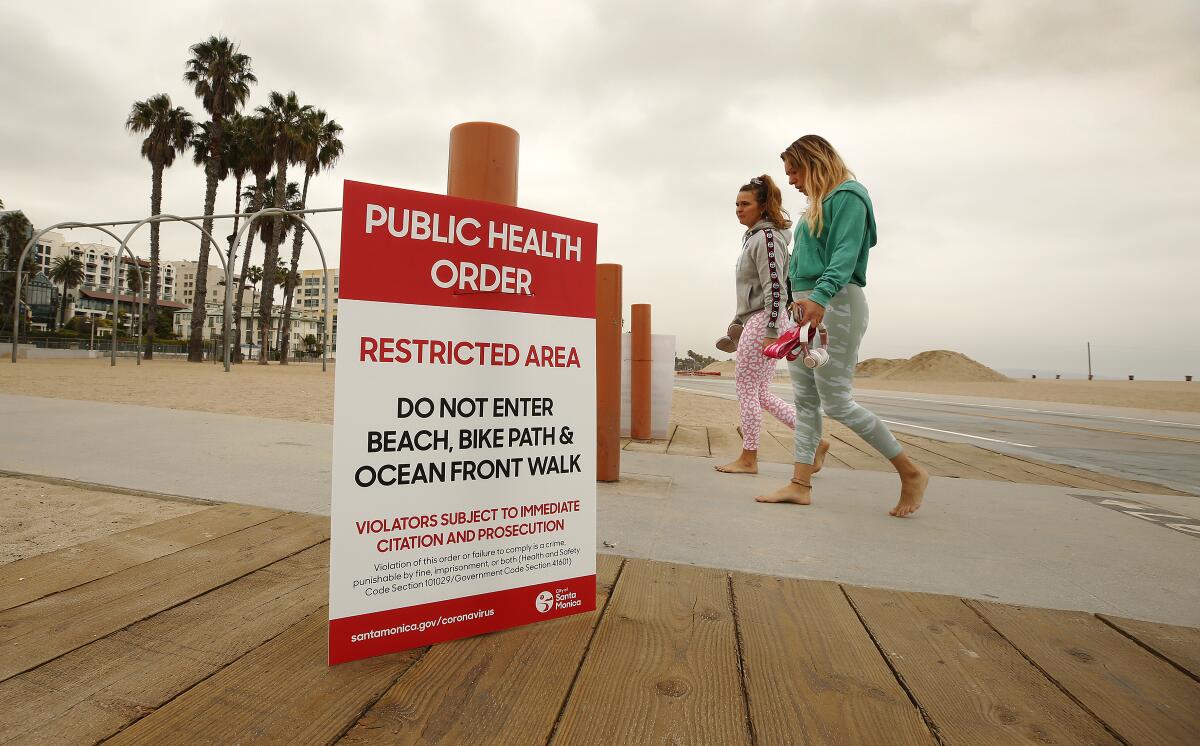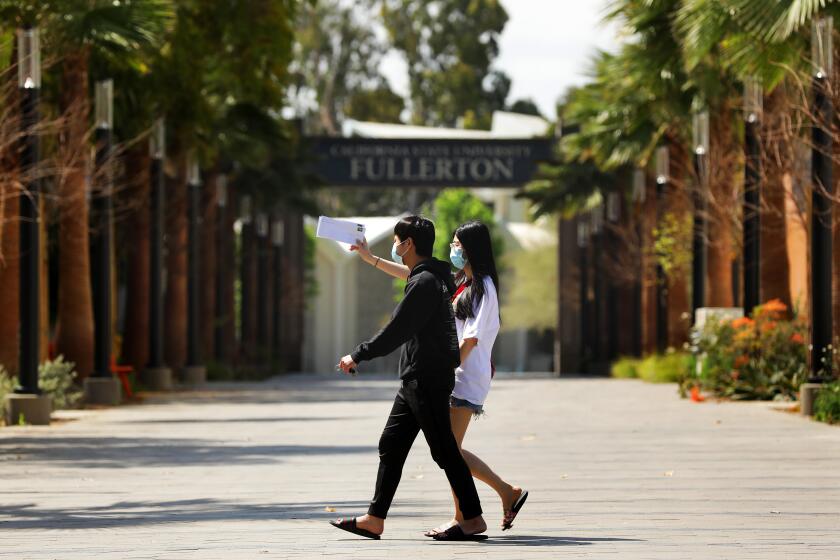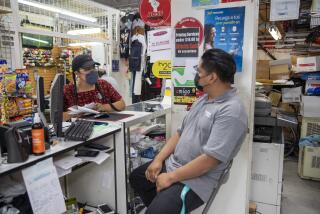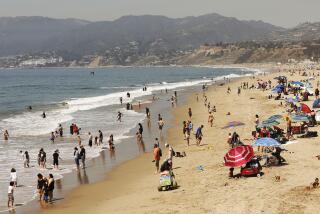New signs that coronavirus restrictions are here for the long haul in California

- Share via
SACRAMENTO — Even as officials laid out more tentative plans to reopen California’s battered economy, there were growing signs Tuesday that life would not be getting back to normal any time soon.
The 23-campus California State University system plans to all but cancel in-person classes in the fall and instead will offer instruction primarily online, with some limited exceptions that allow for in-person activity. The decision comes as schools throughout the country grapple with how long to keep campuses closed amid the coronavirus crisis.
“Our university when open without restrictions and fully in person … is a place where over 500,000 people come together in close and vibrant proximity,” Chancellor Timothy White said at a meeting of Cal State’s Board of Trustees. “That approach sadly just isn’t in the cards now.”
He also acknowledged that the university system lacks the resources to provide coronavirus testing for everybody and trace the contacts of infected people should there be an outbreak on a campus.
Health officials in Los Angeles County — a coronavirus hot spot in California with more than 1,600 deaths — also signaled that progress toward reopening could be slow, with some stay-at-home orders lasting well into the summer.
Los Angeles County Public Health Director Barbara Ferrer told the Board of Supervisors on Tuesday that she didn’t see the timeline shortening without “dramatic change to the virus and tools at hand.” She later added that while the stay-at-home policy would likely remain, some individual restrictions will be “gradually relaxed” under the county’s five-step plan.
“Our hope is that by using the data, we’d be able to slowly lift restrictions over the next three months,” she said. But without widely available testing for the coronavirus or rapid home kits that would allow people to test themselves daily, it seems unlikely that the social distancing directives and stay-at-home orders would be completely eased, she said.
Other local officials said they would support lifting more rules if conditions improved and health experts said it’s safe to do so.
“I am eager to reopen more of L.A. County as soon as it’s safe to do so,” said Los Angeles County Supervisor Kathryn Barger. “I’m confident that the more our communities continue to comply, the sooner we can resume normalcy.”
Officials noted that Los Angeles County beaches are set to reopen Wednesday — with some restrictions on activities and other rules in place — just days after officials also lifted restrictions on hiking trails, parks and golf courses, and allowed curbside pickup at nonessential businesses. But there is no specific timetable for what rules could be lifted next.
“We’re not moving past COVID-19, we’re learning to live with it,” Los Angeles Mayor Eric Garcetti said.
Officials were urging caution in other parts of California as well. Silicon Valley’s health officer announced Tuesday that Santa Clara County has no immediate plans to weaken its strict stay-at-home order, saying she couldn’t take that step without increasing the risk to public safety.
CSU plans to cancel most in-person classes this fall and rely mainly on virtual instruction amid the coronavirus crisis, the chancellor announced Tuesday.
The Bay Area’s most populous county, Santa Clara County, was California’s original hot spot of the COVID-19 pandemic. And while levels of the disease haven’t surged to catastrophic levels, they’ve remained steady, and even a small increase in disease transmission would heighten the risk to vulnerable communities, said Dr. Sara Cody, a key architect of the nation’s first regional shelter-in-place order.
“We’re not there yet,” Cody told the Santa Clara County Board of Supervisors on Tuesday. “The conditions really haven’t changed in our county.... We don’t suddenly have a vaccine. We have exactly the same conditions we had in March. If we did ease up, we would see a brisk return of cases, of hospitalizations, and a brisk return of deaths, to be quite blunt.”
There has been a big push in recent weeks to restart the state’s depressed economy. Gov. Gavin Newsom last week announced new protocols for retail stores and some workplaces to reopen.
On Tuesday, Newsom added that California restaurants and shopping malls can soon reopen in counties that meet state standards for testing and success at reducing cases of the coronavirus, but all businesses will have to abide by state guidelines for physical distancing and cleaning regimens.
Counties must have adequate testing and hospital capacity, and the ability to trace those who have been in contact with ill people.
Restaurants can reopen for dine-in service in counties certified as meeting those benchmarks, but they should implement changes to guard against spreading the virus.
Shopping centers including strip malls and outlet malls will be allowed to reopen with in-store customers in counties certified to have contained COVID-19, while car washes and pet groomers can also resume operating with safeguards.
Some rural counties that have seen relatively few cases are likely to be able to meet those benchmarks more quickly than urban counties such as Los Angeles. Indeed, some rural counties with few coronavirus cases in some cases have defied Newsom’s order and reopened earlier than the state allowed.
A Times data analysis last week found that most big California counties are not close to meeting Newsom’s standards. The analysis looked at which counties could pass just the first two criteria — whether deaths have stopped in the last 14 days, and whether there is no more than one case per 10,000 residents in that same time period.
Most of California failed that test, including Los Angeles County. Newsom has suggested that the guidelines would be later modified on a statewide basis, allowing larger counties hit hardest by the outbreak to also reopen more broadly.
The state said Tuesday that seven of California’s 58 counties — mostly rural — have been certified to have met the state’s conditions for additional businesses to reopen: Amador, Butte, El Dorado, Lassen, Nevada, Placer and Shasta counties.
“There are some unique characteristics in some counties where they are hitting on all cylinders,” Newsom said.
Talks are underway with 27 other counties to discuss whether they can expand the reopenings, the governor said, but he noted that conditions are still too serious in Los Angeles and San Francisco counties to modify the guidelines for resuming business.
Cal State officials said they believe it was best to make the decision about the fall term now rather than wait until the summer.
White, the chancellor, said that for the small number of classes where in-person instruction is “indispensable and can be justified” — such as clinical nursing courses, biology labs or merchant marine training — sufficient resources and protocols will have to be in place to ensure the health and safety of students and teachers.
“The enrollment per section will be less; for instruction and research laboratories the distance between participants greater; the need for personal protective equipment appropriate to the circumstance prevalent; and the need to sanitize and disinfect spaces and equipment between users essential,” White said.
On some campuses and within some departments, course offerings will be exclusively virtual.
McGreevy reported from Sacramento, and Shalby and Agrawal from Southern California. Times staff writers Sarah Parvini and Rong-Gong Lin II contributed to this report.
More to Read
Sign up for Essential California
The most important California stories and recommendations in your inbox every morning.
You may occasionally receive promotional content from the Los Angeles Times.

















